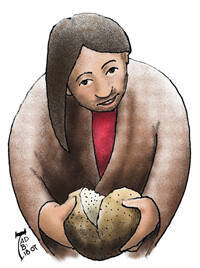It’s All About Jesus
Are you ever annoyed by obtuse people? How do you know you’re not one of them? After all, being obtuse is exactly what would keep one from recognizing the problem. John’s Gospel is filled with contrasts between people who are obtuse and those who possess genuine spiritual acuity. Of course, we are complex enough that we do not neatly fall into such an either/or framework. But John’s Gospel heightens the contrast. It is a narrative of seeing and not seeing, of spiritually dense metaphors often taken literally and superficially. Jesus spoke of being reborn and was thought to be promoting a return to the womb (3:3–4). He offered an inner fountain of life-giving spirit and was imagined to promise lighter water-carting chores (4:14–15). In last week’s Gospel, he fed the multitude as a sign of the reign of God. The people wanted to make him their political ruler, but that was not the kingdom he intended.
This brings us to today’s Gospel reading. When Jesus discovers that the crowd has found him after his narrow escape, he responds, “Amen, amen, I say to you, you are looking for me not because you saw signs but because you ate the loaves and were filled.” The crowd seeks another sign, something by which he could prove himself worthy of being followed. “What can you do? Our ancestors ate manna in the desert, as it was written: ‘He gave them bread from heaven to eat.’” Jesus switches tenses: “It was not Moses who gave the bread from heaven; my Father gives you the true bread.” And while the crowd stays focused on physical bread, Jesus becomes explicit: “I am the bread of life.”
To believe and internalize this truth, Jesus teaches, is the game-changer. It literally makes one a child of God (1:12). It moves one from being an obtuse spirit to an enlightened soul (8:12). To believe in Jesus is the work of God (6:29). Nothing can replace this, and nothing is more valuable.
The church teaches that non-Christians are saved by grace working through their consciences and even their religions. And our call to dialogue means we can learn profoundly from them. While recognizing these truths, it is imperative that we place our minds and hearts squarely on Jesus. He is the icon of the Father through whom we experience the Father’s glory and know what the Father’s being (charact?r) is like (Heb 1:3).
One of the many great insights in the Second Vatican Council’s “Dogmatic Constitution on Divine Revelation” is its understanding of revelation not as a set of doctrines but rather as Christ himself, “the fullness of all revelation,” by whom God speaks to us and lives with us (No. 2). This is Jesus’ point to the crowds in today’s Gospel. “Where’s the sign?” they want to know. “I’m the sign,” Jesus responds. “I am the sign and the reality. I am the bread from heaven.”
One of the holiest people I ever met was a retreat director I got to know during a monthlong retreat. He meditated on the Gospels constantly, and his prayer life was deep and rich. It was obvious he enjoyed great intimacy with Christ. I noticed that he regularly expressed what seemed spiritually wise or unwise by saying, “that feels like the Lord” or “that doesn’t feel like the Lord.” While such proclamations can be instruments of projection or self-delusion in naïve hands, in the hands of one intensely immersed in the Lord, they can reflect Christ himself, who is the ultimate truth. Paul makes a similar point in the second reading: You “were taught in him, as truth is in Jesus.”
How can we be sure we are not spiritually obtuse or at least far less so than we would otherwise be? We must immerse ourselves in him, seek intimacy with him and take on the perspectives, values and imagination he models in the Gospels. When we feed on him, his Spirit dwells ever more deeply in us, and we become increasingly like him.
This article also appeared in print, under the headline “It’s All About Jesus,” in the July 30, 2012, issue.








